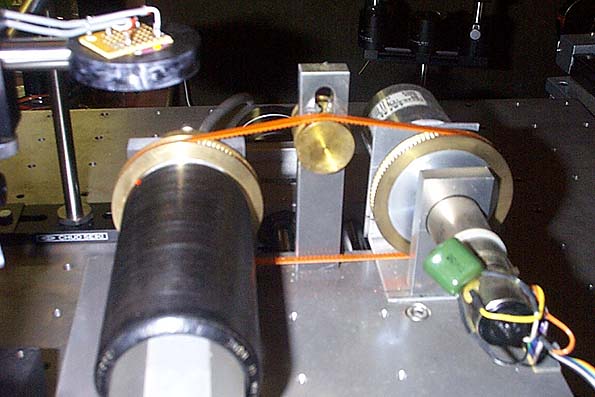
Version: May 5, 2004
 |
|
Version: May 5, 2004 |
|
Since the 1980's, a group of scientists at the University of Hokkaido, Japan, have been working on methods of laser reproduction of phonograph cylinders. The concrete task at hand was to play the cylinders of Polish anthroplogist Bronisław Piłsudski, who in the years 1902 - 1905 recorded the speech and songs of the Ainu people on Sakhalin and Hokkaido. In the process, they also tried their hands at playing discs and galvanos (cylinder moulds). The method they chose for playing cylinders was by directing a laser beam at the bottom of the groove and capturing its reflection on a position sensitive device (PSD). A PSD is an array of photosensors, either in just one row (one-dimensional PSD) or in a square (two-dimensional PSD). For the cylinder player, a two-dimensional PSD war chosen. The modulation of the groove causes the reflection of the laser beam to move up and down over the PSD. This movement is then translated into a sound signal. If the laser beam does not track the groove perfectly, the reflection will move sideways on the PSD. This movement is fed to the mechanics that move the cylinder past the laser and detector, which remain stationary. |

|
This is basically the setup that can be seen on the picture above. The PSD is mounted on a plate at top left, and on the cylinder right below it we can see the red spot of laser light. The laser source is outside of the image. The mandrel and its motor are mounted on a base plate that slides past the laser and detector, driven by a stepping motor. Just like stylus size is critical when using a mechanical pickup, the size of the laser spot is crucial for a good reproduction. If the spot is too big, it will read adjacent tracks and produce an echo effect; if it is too small, it will produce high-frequency noise. The best spot diameter proved to be about 80 µm, the groove spacing being 254 µm on a two-minute cylinder. Spot size is controlled by placing a lens between the laser and the cylinder as seen in the drawing below.
Due to the properties of laser light, the reflection on the surface of the PSD is not a single spot, but a whole diffraction pattern with a number of secondary spots. In the latest player, which uses a 20 mW laser diode working at a wavelength of 780 nm, these spots are blocked out by refocusing the reflected laser beam and letting it pass through a pinhole before reaching the PSD. For playing galvanos - cylinder moulds - the same basic method was used, but the equipment had to be built much more compactly to fit inside the copper tube. To accomplish this, the reflected beam had to take the same way out as it came in. The sound quality obtained from galvanos was much better than from wax cylinders. Cylinders have almost always been played many times, while galvanos are moulds made from pristine wax cylinders. Working on this project over the years have been, besides Takashi Nakamura: Toshimitsu Asakura, Tohro Ifukube, Toshiaki Iwai, Toshio Kawashima, Jun Uozumi and T. Ushikaza. Christer Hamp, 2002 Illustrations provided by Takashi Nakamura
Further reading: Optical methods for Reproducing Sounds from Old Phonograph Records by J. Uozumi and T. Asakura (International Trends in Optics and Photonics, ICO IV, Springer, Berlin, 1999) pdf, 1300 kB Optical Reproduction of Sounds from Old Wax Phonograph Cylinders by T. Nakamura |

| Write to Takashi Nakamura: | Galvanos have also been played by Gerd Stanke in Berlin: | |
